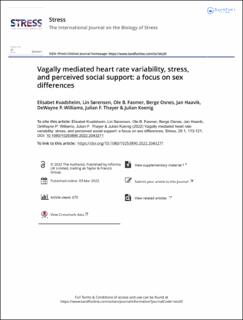Vagally mediated heart rate variability, stress, and perceived social support: a focus on sex differences
Kvadsheim, Elisabet; Sørensen, Lin; Fasmer, Ole Bernt; Osnes, Berge; Haavik, Jan; Williams, DeWayne P.; Thayer, Julian Francis; Koenig, Julian
Journal article, Peer reviewed
Published version

Åpne
Permanent lenke
https://hdl.handle.net/11250/3010938Utgivelsesdato
2022Metadata
Vis full innførselSamlinger
- Department of Clinical Medicine [2066]
- Registrations from Cristin [9791]
Sammendrag
Higher vagally mediated heart rate variability (vmHRV), reflecting vagal activity as indexed by heart function and lower stress vulnerability, is associated with higher perceived social support. Seeking social support is an adaptive stress response, and evolutionary theories suggest that females use this strategy more than males. The current study investigated the hypothesis that higher vmHRV is related to higher perceived social support under conditions of higher, relative to lower, stress, and that this association is most prominent in females. A healthy student sample (n = 143; 82 males, 61 females; mean age 19.9) completed the short version of the Medical outcomes study social support survey (MOS) and the Perceived stress scale (PSS). Activity in the high frequency band of heart rate variability (HF-HRV), deducted from five-minute resting electrocardiogram (ECG) recordings, indexed vmHRV. A moderation analysis was conducted, with PSS and sex as moderators of the association between vmHRV and MOS. Statistical effects were adjusted for age, education, physical activity, body mass index (BMI), alcohol and drug use, ECG-derived respiration (EDR), and mean heart rate. Higher PSS scores moderated the association between vmHRV and MOS in females but not males. Lower PSS scores did not moderate the relation between vmHRV and MOS. This suggests that higher vmHRV is associated with higher perceived social support under conditions of higher stress in females but not males, consistent with evolution of different stress management strategies in the sexes. The results may have implications for individualized intervention strategies for increasing vmHRV and perceived social support.
